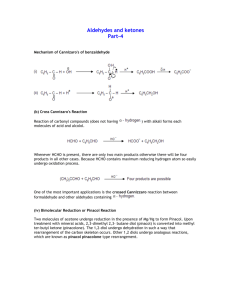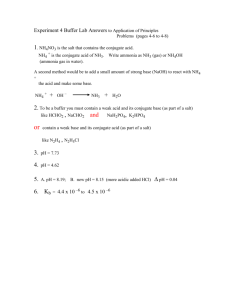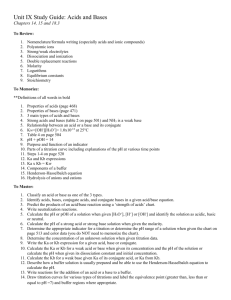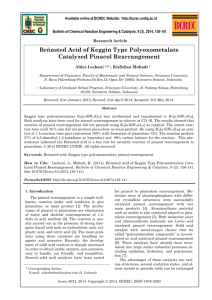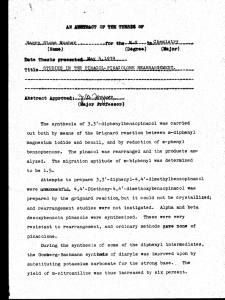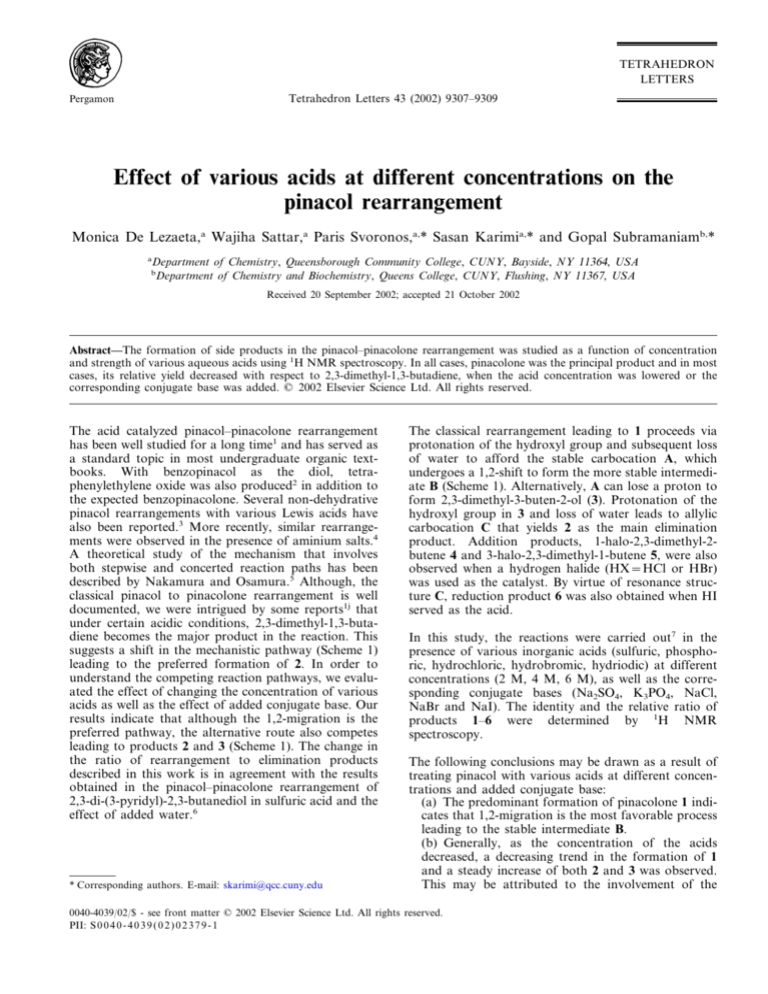
TETRAHEDRON
LETTERS
Tetrahedron Letters 43 (2002) 9307–9309
Pergamon
Effect of various acids at different concentrations on the
pinacol rearrangement
Monica De Lezaeta,a Wajiha Sattar,a Paris Svoronos,a,* Sasan Karimia,* and Gopal Subramaniamb,*
a
Department of Chemistry, Queensborough Community College, CUNY, Bayside, NY 11364, USA
Department of Chemistry and Biochemistry, Queens College, CUNY, Flushing, NY 11367, USA
b
Received 20 September 2002; accepted 21 October 2002
Abstract—The formation of side products in the pinacol–pinacolone rearrangement was studied as a function of concentration
and strength of various aqueous acids using 1H NMR spectroscopy. In all cases, pinacolone was the principal product and in most
cases, its relative yield decreased with respect to 2,3-dimethyl-1,3-butadiene, when the acid concentration was lowered or the
corresponding conjugate base was added. © 2002 Elsevier Science Ltd. All rights reserved.
The acid catalyzed pinacol–pinacolone rearrangement
has been well studied for a long time1 and has served as
a standard topic in most undergraduate organic textbooks. With benzopinacol as the diol, tetraphenylethylene oxide was also produced2 in addition to
the expected benzopinacolone. Several non-dehydrative
pinacol rearrangements with various Lewis acids have
also been reported.3 More recently, similar rearrangements were observed in the presence of aminium salts.4
A theoretical study of the mechanism that involves
both stepwise and concerted reaction paths has been
described by Nakamura and Osamura.5 Although, the
classical pinacol to pinacolone rearrangement is well
documented, we were intrigued by some reports1j that
under certain acidic conditions, 2,3-dimethyl-1,3-butadiene becomes the major product in the reaction. This
suggests a shift in the mechanistic pathway (Scheme 1)
leading to the preferred formation of 2. In order to
understand the competing reaction pathways, we evaluated the effect of changing the concentration of various
acids as well as the effect of added conjugate base. Our
results indicate that although the 1,2-migration is the
preferred pathway, the alternative route also competes
leading to products 2 and 3 (Scheme 1). The change in
the ratio of rearrangement to elimination products
described in this work is in agreement with the results
obtained in the pinacol–pinacolone rearrangement of
2,3-di-(3-pyridyl)-2,3-butanediol in sulfuric acid and the
effect of added water.6
* Corresponding authors. E-mail: skarimi@qcc.cuny.edu
The classical rearrangement leading to 1 proceeds via
protonation of the hydroxyl group and subsequent loss
of water to afford the stable carbocation A, which
undergoes a 1,2-shift to form the more stable intermediate B (Scheme 1). Alternatively, A can lose a proton to
form 2,3-dimethyl-3-buten-2-ol (3). Protonation of the
hydroxyl group in 3 and loss of water leads to allylic
carbocation C that yields 2 as the main elimination
product. Addition products, 1-halo-2,3-dimethyl-2butene 4 and 3-halo-2,3-dimethyl-1-butene 5, were also
observed when a hydrogen halide (HX=HCl or HBr)
was used as the catalyst. By virtue of resonance structure C, reduction product 6 was also obtained when HI
served as the acid.
In this study, the reactions were carried out7 in the
presence of various inorganic acids (sulfuric, phosphoric, hydrochloric, hydrobromic, hydriodic) at different
concentrations (2 M, 4 M, 6 M), as well as the corresponding conjugate bases (Na2SO4, K3PO4, NaCl,
NaBr and NaI). The identity and the relative ratio of
products 1–6 were determined by 1H NMR
spectroscopy.
The following conclusions may be drawn as a result of
treating pinacol with various acids at different concentrations and added conjugate base:
(a) The predominant formation of pinacolone 1 indicates that 1,2-migration is the most favorable process
leading to the stable intermediate B.
(b) Generally, as the concentration of the acids
decreased, a decreasing trend in the formation of 1
and a steady increase of both 2 and 3 was observed.
This may be attributed to the involvement of the
0040-4039/02/$ - see front matter © 2002 Elsevier Science Ltd. All rights reserved.
PII: S 0 0 4 0 - 4 0 3 9 ( 0 2 ) 0 2 3 7 9 - 1
M. De Lezaeta et al. / Tetrahedron Letters 43 (2002) 9307–9309
9308
Scheme 1.
increasingly larger quantity of water present, which
can act as a base to remove the adjacent protons
from both intermediates C and A to afford 2 and 3,
respectively.
(c) In most reactions, addition of the corresponding
conjugate base also increased the formation of 2 and
3. This may be interpreted by the fact that as the
ionic strength of the mixture increases, the anion
present can act as a base and favor elimination.
(d) With addition of hydrogen halides (chloride or
bromide), two addition products 4 and 5 were also
formed, with 4 being the predominant isomer (thermodynamic product). The quantities of 4 and 5 also
increased with increasing acid concentration (Tables
1 and 2).
(e) Phosphoric is the weakest of all acids used (Ka=
7.5×10−3). Although the relative trend of product
ratio compares well with all other cases, the overall
mass yield of products decreased with decreasing
concentration of the acid (Table 1). This suggests
that the hydronium ion concentration is not sufficient
to affect protonation and subsequent rearrangement.
Furthermore, addition of the conjugate base reduced
the mass yield of products even further, presumably
by reducing the effective concentration of the hydronium ion (Table 2).
Table 1. Ratio of pinacolone to various alkenes in the absence of added conjugate base
Acid
Measured quantity
2M
4M
6M
HCl
Product ratio
Product mass (g)
Distillation range
Product ratio
Product mass (g)
Distillation range
Product ratio
Product mass (g)
Distillation range
Product ratio
Product mass (g)
Distillation range
Product ratio
Product mass (g)
Distillation range
100:33:10:0:0:0
1.07
84–94
100:25:7:0:0:0
0.90
80–85
100:16:5:0:0:0
1.06
84–93
100:18:4:0:0:0
1.06
84–87
100:25:15:0:0:0
0.05
85–87
100:14:0:0:0:0
1.16
84–94
100:18:2:0:0:0
1.00
80–85
100:2:0:0:0:0
0.77
74–88
100:15:1:0:0:0
1.08
83–85
100:31:10:0:0:0
0.41
83–97
100:26:0:8:7:0
1.13
84–94
100:16:2:2:0:0
1.09
80–85
100:0:0:0:0:10
0.66
63–72
100:10:0:0:0:0
0.83
83–85
100:16:5:0:0:0
1.08
80–95
HBr
HI
H2SO4
H3PO4
(°C)
(°C)
(°C)
(°C)
(°C)
M. De Lezaeta et al. / Tetrahedron Letters 43 (2002) 9307–9309
9309
Table 2. Ratio of pinacolone to various alkenes in the presence of added conjugate base
Acid
Measured Quantity
2M
4M
6M
HCl
Product ratio
Product mass (g)
Distillation range
Product ratio
Product mass (g)
Distillation range
Product ratio
Product mass (g)
Distillation range
Product ratio
Product mass (g)
Distillation range
Product ratio
Product mass (g)
Distillation range
100:42:10:11:0:0
1.01
84–94
100:26:5:0:0:0
1.06
80–85
100:19:5:0:0:0
1.09
80–93
100:23:5:0:0:0
1.04
77–92
No reaction
0
NA
100:31:4:3:4:0
0.75
84–94
100:21:2:0:0:0
0.97
80–85
100:2:0:0:0:0
0.70
81–87
100:18:1:0:0:0
1.06
83–85
100:25:20:0:0:0
0.06
83–97
100:22:0:13:10:0
1.12
84–94
100:22:4:3:0:0
0.95
80–85
100:0:0:0:0:11
0.68
63–74
100:11:0:0:0:0
1.05
83–85
100:33:6:0:0:0
0.42
80–95
HBr
HI
H2SO4
H3PO4
(°C)
(°C)
(°C)
(°C)
(°C)
Product ratio represents the relative amounts of pinacolone (1), 2,3-dimethyl-1,3-butadiene (2), and 2,3-dimethyl-3-buten-2-ol (3), 1-halo-2,3dimethyl-2-butene (4), 3-halo-2,3-dimethyl-1-butene (5), 2,3-dimethyl-1-butene (6).
Tables 1 and 2 show the mass balance and distillation range for all the reactions. The data shown in Tables 1 and 2 is an average of two
independent experiments. The relative amounts of products were normalized with respect to pinacolone. The maximum concentration of HI was
only 5.6 M.
(f) Use of concentrated hydriodic acid (5.6 M) led to
a dark solution which was indicative of iodine formation (verified by oxidation of NaHSO3). The 1H NMR
spectrum of the distillate indicated the surprising
formation of 2,3-dimethyl-1-butene 6, and the complete absence of 2 (Tables 1 and 2). Apparently the
allylic carbocation C underwent reduction to form
molecular iodine as a byproduct.
In conclusion, this study demonstrates that there exists
a competition between the favorable 1,2-migration and
the alternative reaction paths leading to products 2 and
3. With both increasing dilution of the acid as well as
added conjugate base, the mechanistic pathway is shifted
toward elimination. The observation of the two addition
products 4 and 5, especially with 6 M HCl, reflect the
relative stability of the resonance-stabilized intermediate
allylic cations C and D. The highest ratio of elimination
to rearrangement products observed with added NaCl
can be correlated with the strongly basic character of
chloride ion. In contrast, the much weaker nature of the
iodide ion did not lead to the formation of either 2 or
3; instead, reduction product 6 was obtained.
2.
3.
4.
5.
6.
7.
Acknowledgements
This work was supported by the Research Foundation
of the City University of New York. The authors thank
Professors W. F. Berkowitz and R. Bittman of Queens
College–CUNY and Professor N. McKelvie of City
College–CUNY for their valuable suggestions.
References
1. (a) Carey, F. A.; Sundberg, R. J. Advanced Organic Chemistry, Part B, 3rd ed.; Plenum, 1993; p. 499; (b) March, J.
Advanced Organic Chemistry: Reactions, Mechanisms, and
Structure, 4th ed.; Wiley-Interscience, 1992; p. 1072; (c)
Partridge, D. A. Edu. Chem. 1983, 20, 12; (d) Lowry, T. H.;
Richardson, K. S. Mechanism and Theory in Organic Chemistry, 2nd ed.; Harper & Row, 1981; p. 373; (e) Sykes, P. A
Guidebook to Mechanism in Organic Chemistry, 5th ed.;
Longmans, 1975; p. 112; (f) Pocker, Y. In Molecular
Rearrangements; De Mayo, P., Ed.; Wiley-Interscience: New
York, 1963; pp. 15–25; (g) Deno, N. C.; Perizzolo, C. J. Org.
Chem. 1957, 836; (h) Duncan, J. F.; Lynn, K. R. J. Chem.
Soc. 1956, 3512; (i) Gebhart, H. J.; Adams, K. H. J. Am.
Chem. Soc. 1954, 76, 3925; (j) Allen, C. F. H.; Bell, A. Organic
Synthesis, Coll. Volume 3 1955, 312 and references cited
therein.
Kakimoto, M.; Seri, T.; Imai, Y. Bull. Chem. Soc. Jpn. 1988,
61, 2643 and references cited therein.
(a) Kita, Y.; Yoshida, Y.; Mihara, S.; Furukawa, A.;
Higuchi, K.; Fang, D.; Fujioka, H. Tetrahedron 1998, 54,
14689; (b) Bhushan, V.; Chandrasekaran, S. Chem. Lett.
1982, 1537.
Lopez, L.; Mele, G.; Mazzeo, C. J. Chem. Soc., Perkin Trans.
1 1994, 7, 779.
Nakamura, K.; Osamura, Y. J. Am. Chem. Soc. 1993, 115,
9112.
Loeser, E.; Chen, G. P.; He, T.; Prasad, K.; Repic, O.
Tetrahedron Lett. 2002, 43, 2161.
The following procedure was used: 1.47 g (12.5 mmol) of
pinacol hexahydrate (Aldrich) was combined with 5.0 mL
of the acid and the mixture was distilled using a constant-temperature oil bath (130–135°C). The mass balance and
temperature range for the mixture of distillate are listed in
Tables 1 and 2. The distillate was collected (15–20 min) in
an ice-water bath in a closed system, dried, and its 1H NMR
spectrum was obtained (CDCl3, Bruker Avance-DPX 400
MHz NMR). For experiments that involved the use of
conjugate base, 0.44 g of the corresponding anhydrous
conjugate base was dissolved in 5.0 mL of the acid before
mixing with 1.47 g of pinacol hexahydrate. The conjugate
bases used include sodium sulfate, potassium phosphate,
sodium chloride, sodium bromide and sodium iodide. The
acid solutions were made by diluting commercially available
concentrated sulfuric (18 M), phosphoric (15 M), hydrochloric (12 M), hydrobromic (8.8 M), and hydriodic (5.6 M) acids.




